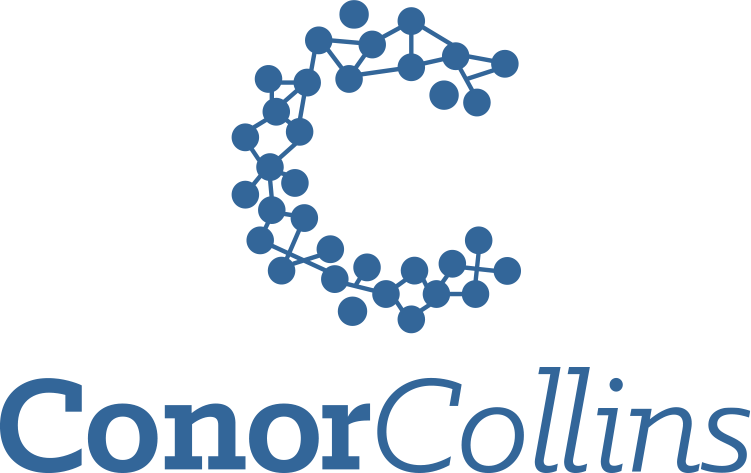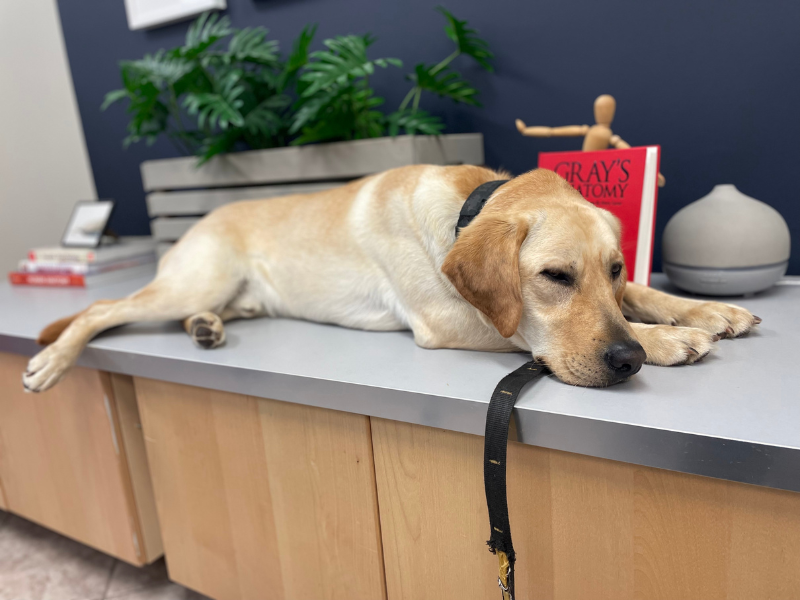If you’ve worked with people in an exercise setting for any period of time, you’ve either knowingly or unknowingly been working in the field of skill acquisition. Webster’s Dictionary defines a “skill” as “a learned power of doing something competently: a developed aptitude or ability”. I’ve been thinking to myself lately, what exactly is “competence” as it concerns skill acquisition? In the past, I would have preferred a rigid definition, but I’m in a place in my career where a softer version makes more sense.
I think most would assume I arrived at this understanding solely through years of practice but training my puppy, Huxley, has been a major accelerator in my understanding of teaching competence to people in rehabilitation. Seeing skill acquisition through the eyes of a new puppy in training has deepened my understanding; “competence” is very dynamic, ever-changing, and highly person-dependent. Whether the person is competing in a power lifting competition, or is learning to walk again following a broken leg, competence in either scenario (or any in between) will be unique to that person’s individual experience.
Everyone has a starting point, and typically each individual is moving towards their own finish line. People tend to move the goal posts to their finish lines as life is constantly changing. For this reason, getting a sense of a person’s goals can be helpful in determining the rehabilitation plan.
Goal Setting
Measuring competence in skill acquisition is void of meaning if it’s not important to the person in front of you. For example, if a clinician is focused on having someone lift a heavy object overhead, but the person doesn’t have a need or a care to do it, then why would we as clinicians be attached to that goal? I begin skill acquisition with trying to establish personal and meaningful goals. Goals should ideally be related to what a person would like to do or achieve. Once a person has established their goals, I may offer alternative, or additional goals, that I think may be useful. These may serve as an either adjunct, or stepping stone, towards to the primary goal. For example, let’s take a person who has a goal of squatting 50 lbs. If that’s their only goal and they’re recovering from an injury, it’s reasonable to suggest squatting pain-free first, before adding load to the movement.
Where to Begin
Once goals have been established, it’s time to get to work. Wherever possible, exercise should be something fun and meaningful, however; there will be circumstances where exercise won’t feel fun to a person. If you ask most people how “fun” it is to bend their knee a couple days post-total knee replacement, they will tell you it isn’t fun. Under such circumstances I try my best to re-assure, collaborate, and communicate with the person. Often times a gentle reminder of the end goal is helpful, and an assurance that you’ll take it one step at a time.
When speaking with others about movement, exercise, and skill acquisition, the topic of “ideal” movement comes up rather regularly. While ideal moments and postures don’t exist, I consider several factors before beginning exercise. A few of these are:
Pain – Is the person experiencing pain? Does participating in various forms of movement aggravate or improve movement?
Fear – Is the person scared of a particular skill and why?
Compliance – Is the person willing to openly engage in movement as part of their care plan? How much time daily or weekly are they willing to commit to movement?
Barriers – Does the person have physical, social, or psychological barriers to movement?
Equipment – Does the person have open access to equipment?
Goals – Do they have goals and how do we achieve them?
Once these factors have been reviewed at length it’s time to empower people through moving their bodies in meaningful and empowering way.
Attentional Focus
As clinicians or coaches when it’s time, it’s time to teach. Teaching methods will always vary person-to-person, for some, “teaching” may mean quietly observing, while others may request specific verbal or physical instruction of a skill.
When teaching a skill, a common discussion point is the use of attentional focus strategies. Attentional focus, simply put, is noticing where one’s attention goes. The two primary types of attentional focus are internal focus and external focus.
Wulf et al. (1998) define internal focus as directing individuals to focus on their body movements2. A common example of internal focus may be a clinician directing a person to “squeeze their glutes” while they are lying on their back on the floor. A primary goal here may be for the person to lift the hips off of the ground into a bridge position. This attentional strategy relies on the person already understanding what the directive means and what the structures in question are; I am certainly guilty of making these assumptions as a clinician.
Years ago, I was treating someone’s hamstring on the table.
I asked them, “what do you think I am doing?”
They replied confidently, “you are breaking up scar tissue in my leg, that then goes into my blood stream towards my heart where I breathe it out.”
To their reply I asked, “where did you learn that?”
To which they said, “I didn’t, that’s just what I think you are doing.”
With our current understanding of the mechanisms of manual therapy, needless to say, we understand this individual’s thought process is not consistent with the research. The more important outcome of this conversation was the realization that people’s interpretation of what we do as manual therapists will vary greatly.
From this point onward, I shifted almost all my attentional focus strategies to external focus. When it comes to attentional focus and movement, many bodies of research have cited a preference towards using external focus3,4. External focus is directing focus to a movement(s) effect on the environment2. If we take the same example of the bridge exercise, the cue may read something as follows: “pretend there is fire under your buttocks and push away from it” or “bring your belt line towards the ceiling”. These cues attempt to be simplify exercise through the use of things in the environment to help achieve a desired result.
For certain individuals attentional focus may not allow a person to follow grasp the concept of the intending movement or skills being taught. In these circumstances I’ve started to incorporate other elements of dog training into my daily clinical practice. These include free shaping, luring and capturing.
Shaping
Dogs don’t understand English. They understand sounds and how sound relates to movement, pressure, and reward. Dogs respond to various forms of pressure. Examples of pressure may include: leash pressure, environmental pressure, or social pressure. I equate pressure in dog training to exercise difficulty. Difficulty can be alternated through resistance, speed, or environment to name a few. When a skill is completed under pressure, it is reinforced. Reinforcement is to help solidify a skill and cement in the dog’s mind. Types of positive reinforcement include praise, food, or play. Depending on the skill and dog, skills may take 1000s of repetitions in multiple scenarios before they are proofed. Apply too much pressure early in the skill acquisition process and things can get pretty overwhelming pretty quickly.
In dog training when the end goal is complex, a trainer often uses something called free shaping. Free shaping is a process of teaching an animal a skill by rewarding it gradually throughout each step of the process. For example, if I want my dog to stand on a riser, I may reward it for putting one paw on the riser, then two and so on, until they are eventually standing on the riser.
I’ve started using free shaping as part of my exercise prescription process clinically. I find this particularly useful when people are scared to move in the presence of pain. If a person is too scared to pick something up off the floor, we may start our first session by picking something up off of a chair. Over time we gradually lower the platform closer towards to floor, in hopes that the person will eventually be able to lift from the floor pain-free.
Luring
Luring is maybe the most common method used in dog training. Luring is the process of taking a treat (or toy), guiding the dog into a desired behaviour, marking it and rewarding it. Over time the lure is faded out (removed), a hand signal is added and eventually a verbal cue.
I’ve found using environment lures in exercise to be particularly helpful when pain is a prominent symptom. For example, when a person is performing a squat I may hold a ball in front of them and ask them to reach for it as they squat. In other circumstances, I may use a visual lure of focusing on an object while performing a certain skill. As the person is focused on the lure they may experience less pain. Luring also reinforces the idea of external attentional focus, as a person is actively focusing on the environment in which they are moving.
Capturing
Capturing is marking a behaviour without prompting or guidance. For example: Huxley is lying on his bed in a relaxed position, I walk by and mark the behaviour with a verbal “yes” and give him a treat. Huxley thinks, “I just got a treat for lying here, I am going to do more of that”. Huxley has completed the skill knowingly or unknowingly and is being rewarded for it.
Capturing for me may be the most beneficial method of teaching skill acquisition. I’ll usually say, “that was it, do more of that” or try and capture a pain-free moment with the prompt, “you didn’t appear to have pain there did you?” I am trying to create a snapshot of the skill and capture a eureka moment for the person.
In the context of skill acquisition within my clinical practice, I use capturing, luring and shaping in various forms all of the time. If I find a person responding better to one type of learning, I’ll lean on that one more. Do I know why certain people respond better to certain types of learning? No. I am not overly concerned with that, as long as the person ultimately ends up where they would like to be in their rehabilitation.
In my own skill acquisition journey with Huxley, these past two years have been a fascinating journey. I have never been more frustrated, proud, happy, and angry, sometimes all within a span of a minute. Dog training for me has been a perfect lesson in patience and leadership when it comes to skill acquisition. An additional gift has been the way that it has allowed me to reframe a major aspect of my clinical practice and movement. I hope that you can take some of these tools and and use them in a way that’s meaningful to you. Happy training!
References
- Chen T.T, Mak T.C.T, Ng S.SM, & Wong T.W.L. Attentional Focus Strategies to Improve Motor Performance in Older Adults: A Systematic Review. Int J Environ Res Public Health. 2023, 20(5):4047. doi: 10.3390/ijerph20054047.
- Wulf, G., Höß, M., Prinz, W. Instructions for Motor Learning: Differential Effects of Internal Versus External Focus of Attention. J Mot Behav. 1998, 30(2): 169–179. doi: 10.1080/00222899809601334.
- Land, W.M., Frank, C., Schack, T. The Influence of Attentional Focus on the Development of Skill Representation in a Complex Action. Psychol. Sport Exerc. 2014, 15(1): 30–38. https://doi.org/10.1016/j.psychsport.2013.09.006.
- Wulf, G., McNevin, N.H., Fuchs, T.,Ritter, F.,Toole, T. Attentional Focus in Complex Skill Learning. Res. Q. Exerc. Sport 2000, 71(3): 229–239. doi: 10.1080/02701367.2000.10608903.
About the Author
Conor’s Sports Injury Therapy background has earned him a growing reputation in the professional sports industry. Conor has consulted for athletes in the NHL, NCAA and IHHF and he was a therapist at the 2015 Pan AM games in Toronto.
When he’s not at the clinic, Conor’s teaching at Mohawk College in the Massage Therapy program or teaching his course “Understanding the Complexity of Concussion” internationally. Conor has written for a variety of magazine and news outlets, as well as participated as an expert at a number of internationally-recognized conferences.



Recent Comments